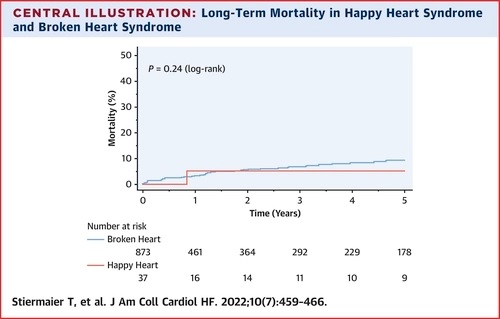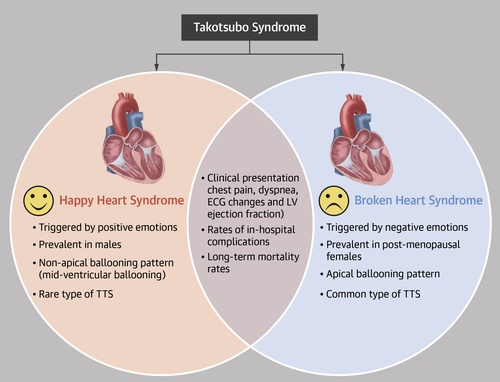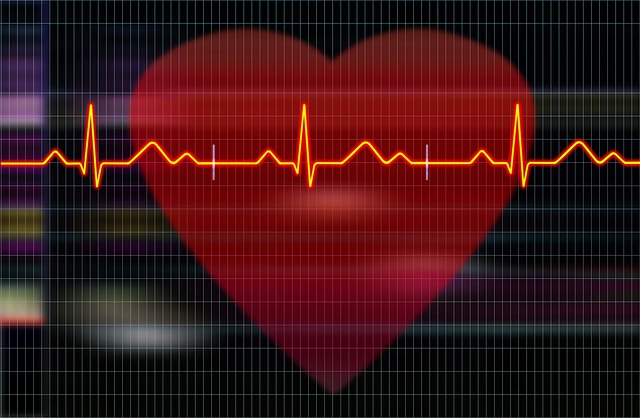Background
Association with a previous stressor is a characteristic feature of Takotsubo Syndrome (TTS). Negative emotions before TTS are common and led to the popular term "broken heart syndrome . " In contrast, pleasurable triggers (“happy heart syndrome” ) are rare and barely researched.
Goals
The authors analyzed the frequency, clinical characteristics and prognostic implications of positive emotional stressors in the multicenter GEIST (GErman-Italian-Spanish Takotsubo) registry.
Methods
Patients enrolled in the registry were categorized according to their stressors. This analysis compared patients with pleasant emotional events with patients with negative emotional events .
Results
Of 2,482 patients in the registry, 910 patients (36.7%) exhibited an emotional trigger consisting of 873 "broken hearts" (95.9%) and 37 "happy hearts" (4.1%). Consequently, the prevalence of pleasant emotional triggers was 1.5% of all TTS cases.
Compared with TTS patients with prior negative events, happy heart syndrome patients were more often male (18.9% vs. 5.0%; P < 0.01) and had a higher prevalence of ballooning patterns. atypical (27.0% vs. 12.5%; P = 0.01), particularly midventricular bulging.
In-hospital complications, including death, pulmonary edema, cardiogenic shock, or stroke (8.1% vs. 12.3%; P = 0.45), and long-term mortality rates (2.7% vs. 8%; P =0.20) were similar in “happy hearts” and “broken hearts” .
Conclusions Happy heart syndrome is a rare type of TTS characterized by a higher prevalence of male patients and atypical non-apical ballooning compared to patients with negative emotional stressors. Despite the similar short- and long-term results in our study, additional data are needed to explore whether the numerically lower event rates in “happy hearts” would be statistically significant in a larger sample size. |

Editorial (summary)
In summary, the findings of this clinical study support existing evidence that happy triggers can also cause Takotsubo Syndrome (TTS). According to the researchers, the clinical presentation, including chest pain, dyspnea, electrocardiographic changes, and left ventricular ejection fraction, was similar between the 2 sides of TTS. Furthermore, despite statistically reduced event rates in patients with “ happy heart syndrome ,” the study found that in-hospital complications such as death, pulmonary edema, cardiogenic shock or stroke and long-term mortality rates are similar in positive and positive cases .
The authors concluded that “happy heart syndrome” is a rare type of TTS characterized by a higher prevalence in male patients , with transient wall abnormalities as features of atypical and non-apical ballooning, specifically mid-ventricular ballooning, compared to with cases of "broken heart syndrome" . This study is interesting and is an excellent starting point to update the current state of the field.
It is natural to expect parallels between “happy heart” syndrome and “broken heart” syndrome , as they result in the same clinical condition: TTS. Although “happy heart” syndrome is rare, clinicians should be aware that its occurrence should deserve the same clinical attention as “broken heart” syndrome , as they share similar prognostic implications.

According to the authors, a possible explanation for the rarity of the “happy heart” syndrome is that intense positive emotions in life are less common than negative ones or, more justifiably, because some central modulators are involved in better emotional management of emotions. good news instead of bad.
To date, the specific pathophysiological mechanism associated with TTS in relation to negative emotions remains an enigma to be solved. However, a growing body of evidence reveals that a heart-brain interaction with sympathetic overload and catecholamine excess caused by acute physical or emotional stress is strongly associated with the pathogenesis of this condition.
By examining the parts of the brain that are activated during the experience of specific emotions, researchers have concluded that the amygdala , an almond-shaped mass of gray matter within each cerebral hemisphere, is associated with the processing of both pleasant and negative emotions. . Therefore, it is not surprising to see the implication of positive emotions in TTS. During an acute emotional event, amygdala overactivity has been linked to a sudden increase in catecholamines , and several studies have shown that excess catecholamines play a crucial role in the occurrence of TTS.
















